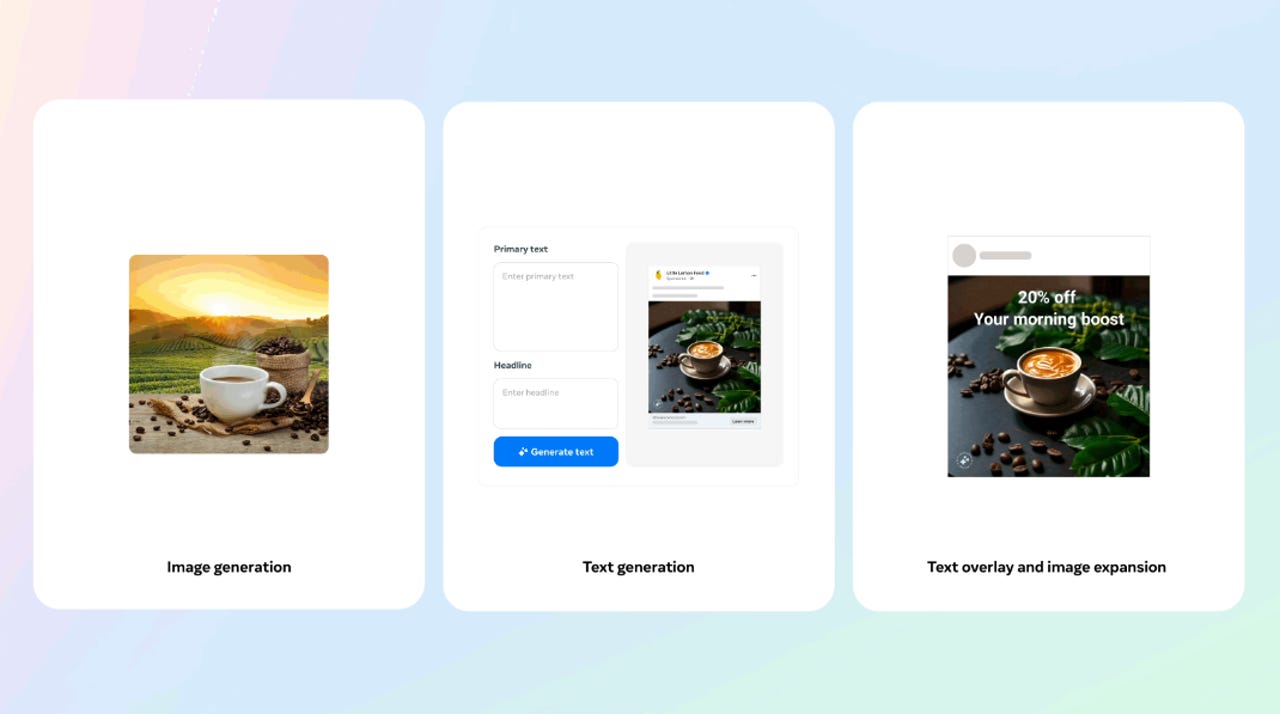Meta's new generative AI features aim to make it easier to create ads - and they're free


Social media feeds are an ideal place to advertise, and a well-executed campaign can help businesses grow significantly -- but creating them is a lot of work. Meta's new generative artificial intelligence (AI) tools aim to help make curating the perfect ad easier.
On Tuesday, Meta unveiled new generative AI features and upgrades that build on its current offerings to assist businesses in creating and editing new ad content, aiming to make the process quicker and more efficient.
Also: Apple's new Logic Pro adds AI 'band members' for iPad and Mac users
Meta first introduced generative AI features for advertisers in October, including background generation, which allows users to swap backdrops for their product images; image expansion, which automatically fits creative assets to different aspect ratios; and text variations, which generates multiple ad text options from an advertiser's original copy.
Now, the company is adding new image and text generation capabilities, the highlight being a new image variation feature that can create alternate iterations of your content based on the original creative.
As seen in the video below, the user's original ad creative, an image of a cup of coffee with a pasture in the background, was transformed into a set of new images that showcase a cup of coffee in front of lush leaves.
The feature is rolling out to users now. In the upcoming months, it will be upgraded to include user text prompts that can customize what the model generates to better fit a user's specific vision. Additionally, users can overlay text on those images, selecting from dozens of font typefaces to complete the ad, as seen below.
These features have the potential to bring a lot of value to businesses by helping already-stretched marketers and business owners save time and money on shooting a new product and carrying out an entirely new campaign.
Meta's new features could also make it easier for businesses to reach their target audiences, as a shoot can be tweaked to suit many different interests without having to go through extensive project planning to bring a new idea to life.
The image expansion feature is being upgraded to include Reels and Feed on both Instagram and Facebook, making it easier for users to adjust the same content across aspect ratios and eliminating the need for manual adjustments.
Similarly, Meta is upgrading the text generation feature to include ad headlines in addition to the primary text. Meta revealed that this text feature will "soon" be built with Llama 3, the company's most advanced large language model (LLM), making the feature more advanced than it currently is and offering advertisers more comprehensive help.
All of the generative AI features are available in Meta's Ads Manager through Advantage+ creative, Meta's hub for optimizing user ad content.
Meta will continue to offer these tools at no additional cost to the user, in the hopes that increased ad performance encourages companies to continue to advertise with Meta. Meta says that companies are already seeing improved ad performance from leveraging some of these tools.
Also: My favorite browser can now summarize articles on Android, thanks to this AI upgrade
For example, Meta shared that the skincare brand Fresh saw a five-time incremental return on ads spend by running Advantage+ shopping campaigns with Shops ads and generative AI text variations. Similarly, Casetify saw a 13% increase in return on ad spend when testing the background generation feature.
Generative AI is great at churning out quality creative content at impressive speed and scale, so we'll continue to see more of these applications that support marketers in the coming months. Recently, Adobe announced a suite of generative AI tools marketers can use to help with everything from generating content for a campaign to deploying it.